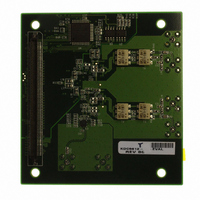KDC5612EVAL Intersil, KDC5612EVAL Datasheet - Page 19

KDC5612EVAL
Manufacturer Part Number
KDC5612EVAL
Description
DAUGHTER CARD FOR KAD5612
Manufacturer
Intersil
Series
FemtoCharge™r
Datasheets
1.KAD5612P-25Q72.pdf
(29 pages)
2.KMB-001LEVALZ.pdf
(7 pages)
3.KDC5514EVALZ.pdf
(9 pages)
Specifications of KDC5612EVAL
Number Of Adc's
2
Number Of Bits
12
Sampling Rate (per Second)
250M
Data Interface
Parallel
Inputs Per Adc
1 Differential
Input Range
1.47 Vpp
Power (typ) @ Conditions
429mW @ 250MSPS
Voltage Supply Source
Single Supply
Operating Temperature
-40°C ~ 85°C
Utilized Ic / Part
KAD5612P-25, KMB001 Motherboard
For Use With
KMB001LEVAL - MOTHERBOARD FOR LVDS ADC CARD
Lead Free Status / RoHS Status
Lead free / RoHS Compliant
Serial Peripheral Interface
A serial peripheral interface (SPI) bus is used to facilitate
configuration of the device and to optimize performance. The
SPI bus consists of chip select (CSB), serial clock (SCLK)
serial data input (SDI), and serial data input/output (SDIO).
The maximum SCLK rate is equal to the ADC sample rate
(f
divided by 66 for reads. At f
SCLK is 15.63MHz for writing and 3.79MHz for read
operations. There is no minimum SCLK rate.
The following sections describe various registers that are
used to configure the SPI or adjust performance or
functional parameters. Many registers in the available
address space (0x00 to 0xFF) are not defined in this
document. Additionally, within a defined register there may
be certain bits or bit combinations that are reserved.
Undefined registers and undefined values within defined
registers are reserved and should not be selected. Setting
any reserved register or value may produce indeterminate
results.
SPI Physical Interface
The serial clock pin (SCLK) provides synchronization for the
data transfer. By default, all data is presented on the serial
data input/output (SDIO) pin in three-wire mode. The state of
the SDIO pin is set automatically in the communication
protocol (described in the following paragraphs). A dedicated
serial data output pin (SDO) can be activated by setting
0x00[7] high to allow operation in four-wire mode.
The SPI port operates in a half duplex master/slave
configuration, with the KAD5612P functioning as a slave.
Multiple slave devices can interface to a single master in
three-wire mode only, since the SDO output of an
unaddressed device is asserted in four-wire mode.
SAMPLE
SCLK
SDIO
CSB
SCLK
SDIO
CSB
) divided by 16 for write operations and f
R/W
A0
SAMPLE
W1
19
A1
W0
A2
= 250MHz, maximum
A12
A11
FIGURE 34. MSB-FIRST ADDRESSING
FIGURE 35. LSB-FIRST ADDRESSING
A11
A12
SAMPLE
A10
W0
KAD5612P
A1
W1
A0
R/W
The chip-select bar (CSB) pin determines when a slave
device is being addressed. Multiple slave devices can be
written to concurrently, but only one slave device can be
read from at a given time (again, only in three-wire mode). If
multiple slave devices are selected for reading at the same
time, the results will be indeterminate.
The communication protocol begins with an
instruction/address phase. The first rising SCLK edge
following a high to low transition on CSB determines the
beginning of the two-byte instruction address command;
SCLK must be static low before the CSB transition. Data can
be presented in MSB-first order or LSB-first order. The
default is MSB-first, but this can be changed by setting
0x00[6] high. Figures 34 and 35 show the appropriate bit
ordering for the MSB-first and LSB-first modes, respectively.
In MSB-first mode the address is incremented for multi-byte
transfers, while in LSB-first mode it’s decremented.
In the default mode the MSB is R/W, which determines if the
data is to be read (active high) or written. The next two bits,
W1 and W0, determine the number of data bytes to be read
or written (see Table 6). The lower 13 bits contain the first
address for the data transfer. This relationship is illustrated in
Figure 36, and timing values are given in “Serial Peripheral
Interface” on page 19.
After the instruction/address bytes have been read, the
appropriate number of data bytes are written to or read from
the ADC (based on the R/W bit status). The data transfer will
continue as long as CSB remains low and SCLK is active.
Stalling of the CSB pin is allowed at any byte boundary
(instruction/address or data) if the number of bytes being
transferred is three or less. For transfers of four bytes or more,
CSB is allowed stall in the middle of the instruction/address
bytes or before the first data byte. If CSB transitions to a high
state after that point the state machine will reset and terminate
the data transfer.
D7
D0
D1
D6
D5
D2
D4
D3
D4
D3
D2
D5
D1D
D6
September 9, 2009
D7
0
FN6803.2











